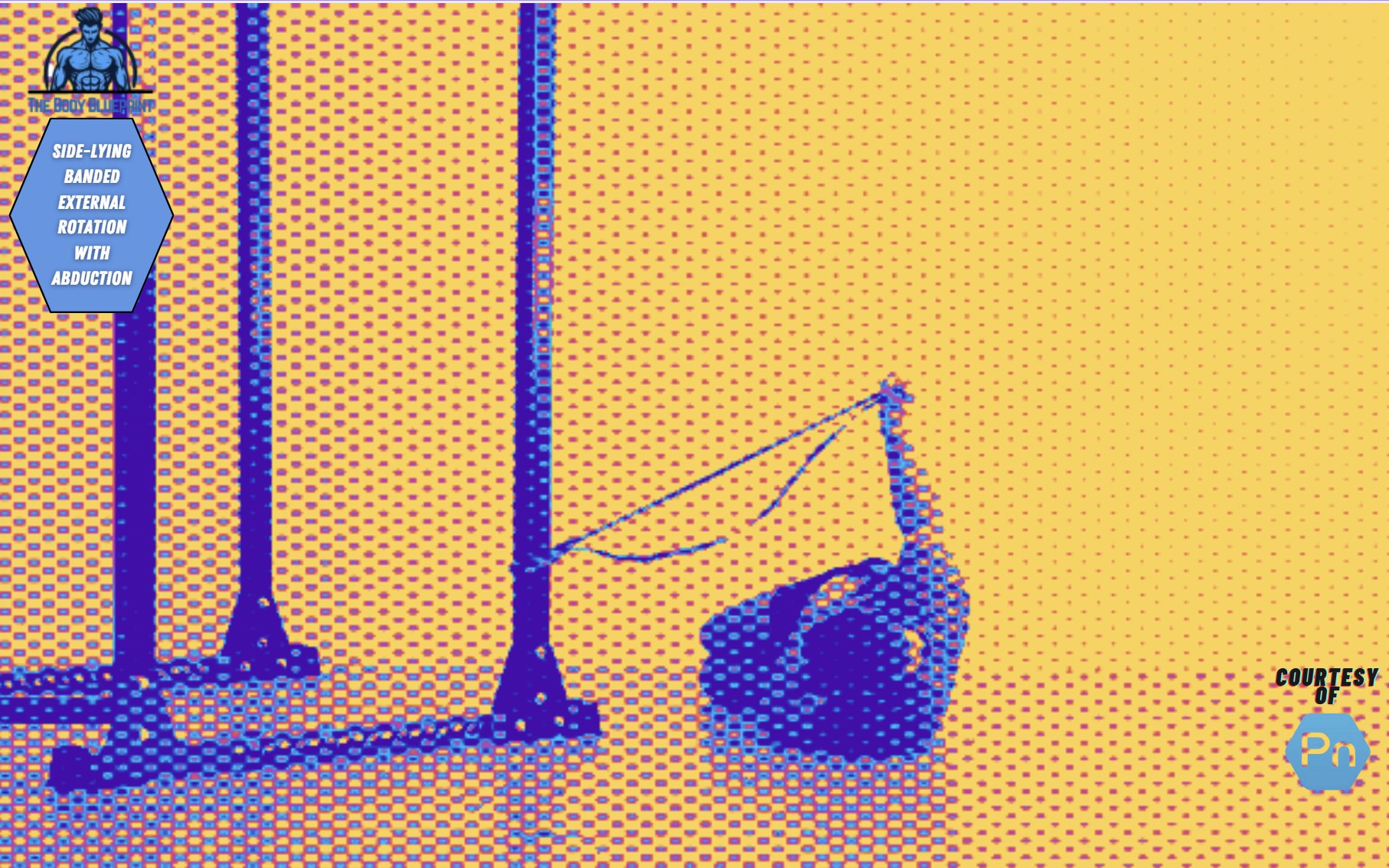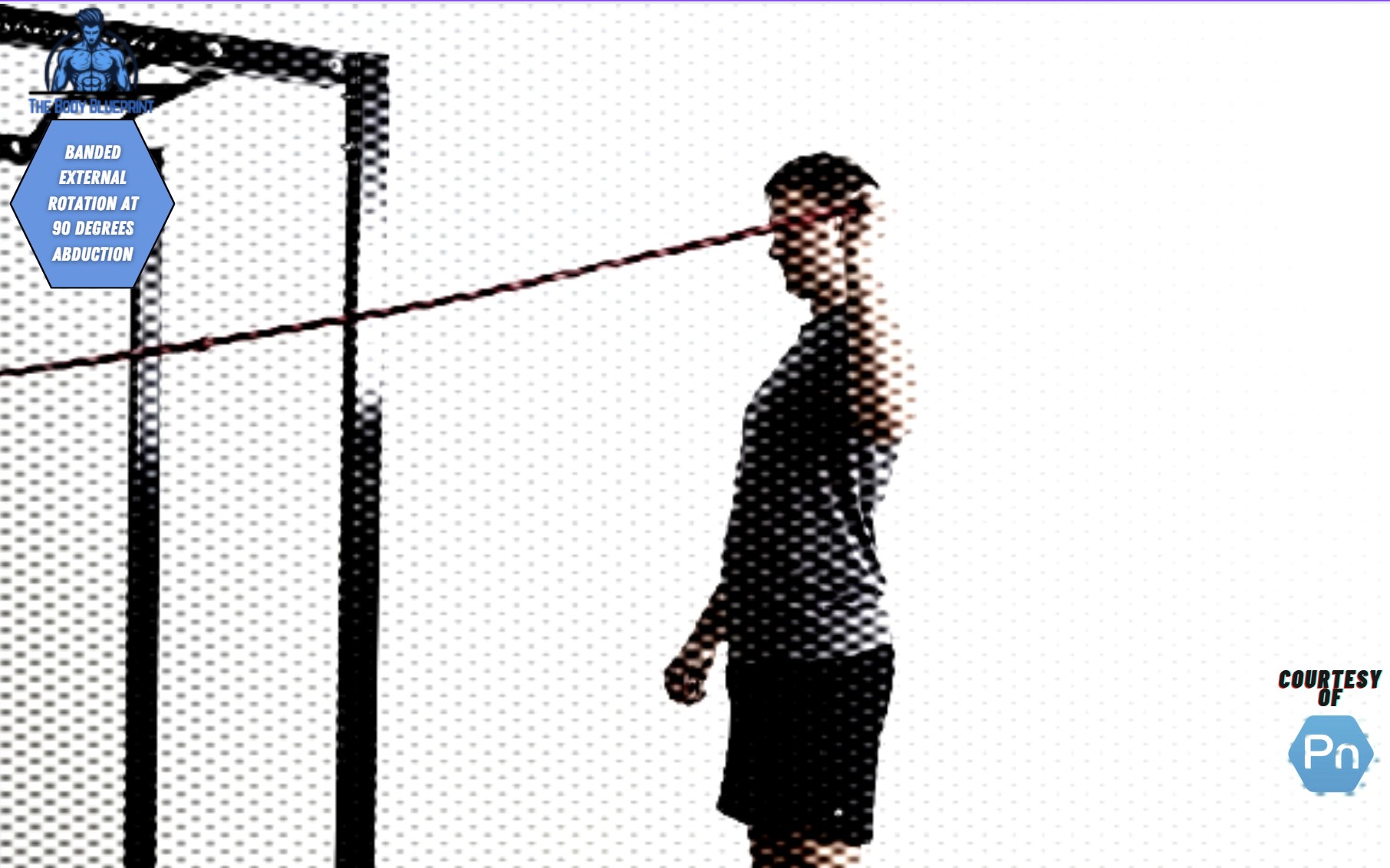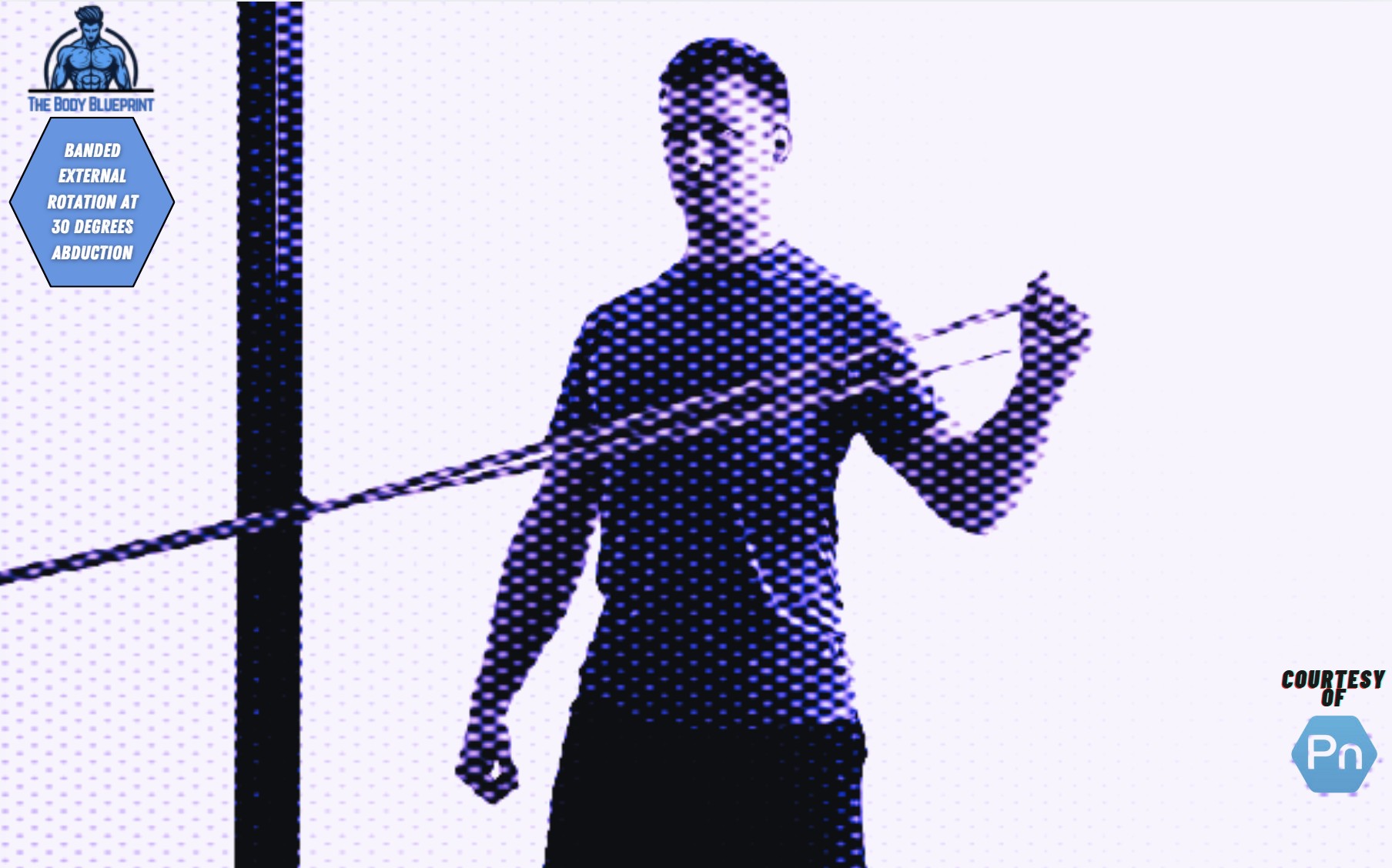Side-Lying Banded External Rotation with Abduction: Perfecting Your Shoulder Mobility
When you think about building strong, durable shoulders, the first thing that comes to mind might be overhead presses, push-ups, or bicep curls. But what if I told you that shoulder health isn’t just about brute strength? It’s also about mobility and control. The Side-Lying Banded External Rotation with Abduction is a game-changer, and it’s exactly what your shoulders need to fire on all cylinders.
What Is the Side-Lying Banded External Rotation with Abduction?
This exercise targets the small muscles of the rotator cuff, focusing on external rotation and abduction to enhance shoulder stability and mobility. If you’re lifting heavy or throwing around weights, neglecting these smaller muscles can lead to injury. This movement is your secret weapon to bulletproof your shoulders, and guess what? You can do it anywhere.
Key Benefits of the Side-Lying Banded External Rotation with Abduction
- Boosts Shoulder Stability: Strengthens the rotator cuff, giving your shoulder joint more stability.
- Increases Range of Motion: Abduction and external rotation work together to improve flexibility and mobility.
- Prevents Injury: Helps with shoulder rehab by strengthening weak areas often ignored in other exercises.
- Better Performance in Lifts: Enhance your pressing movements and overall shoulder health for long-term strength gains.
Performing the Side-Lying Banded External Rotation with Abduction
- Setup:
- Grab a resistance band and secure it to a stable point near the ground.
- Lie on your side, with the band in your top hand.
- Keep your elbow bent at 90 degrees, and the band will be perpendicular to your torso.
- Positioning:
- Make sure your arm is level with the floor. Your top shoulder should be relaxed and in a neutral position. Your body should be stacked in a straight line—no slouching here!
- The Movement:
- Rotate your shoulder outward, keeping the elbow at a 90-degree angle. Your forearm should move away from your body, opening up that shoulder joint.
- Simultaneously, lift the banded arm up toward the ceiling (abduction), focusing on control throughout the motion.
- Reps:
- Aim for 3 sets of 12-15 reps per side, slowly increasing the resistance as you get stronger.
Key Tips for Mastering This Movement
- Engage Your Core: Make sure you keep your torso stable by activating your core. The more stable your body, the more effective this exercise becomes.
- Full Range of Motion: Don’t cheat by cutting the movement short. Fully rotate your shoulder and bring the arm out wide for maximum results.
- Control the Band’s Tension: Don’t let the band control the pace of the movement. Use it to increase resistance, but keep it slow and deliberate as you move.
Banded External Rotation at 90 Degrees Abduction: The Shoulder Game-Changer
If you’ve been doing the same old shoulder exercises, this one will make your shoulders feel like they’re on a whole new level. The Banded External Rotation at 90 Degrees Abduction takes things up a notch, working in the middle of your range of motion to add power to the shoulder joint.
What Is the Banded External Rotation at 90 Degrees Abduction?
This exercise positions your arm at 90 degrees in abduction, effectively isolating the external rotators while maintaining tension throughout the shoulder joint. This is where strength meets control, working the upper arm in a way that builds endurance, mobility, and power.
Why Should You Do the 90-Degree Abduction Rotation?
- Strengthens Rotator Cuff: This move puts direct pressure on the rotator cuff muscles, which play a pivotal role in shoulder strength and mobility.
- Optimizes Shoulder Range: Moving through 90 degrees of abduction helps with unlocking your shoulder joint’s potential range.
- Improves Posture: Strengthening these muscles helps balance shoulder positioning, improving your posture during other lifts or physical activities.
- Perfect for Rehab: If you’ve suffered any shoulder injury, this exercise targets the vulnerable muscles in a controlled manner, speeding up recovery.
How to Perform the Banded External Rotation at 90 Degrees Abduction
- Setup:
- Attach your band to a low anchor point, and grab the other end with your top hand.
- Lie on your side, with your shoulder bent at 90 degrees, and hold the band with your elbow at your side.
- Engage the Core:
- Brace your core to maintain balance. Keeping the rest of your body still is crucial for isolating your shoulder.
- Movement:
- Rotate your arm outward against the band’s resistance. The goal is to keep your elbow fixed at 90 degrees while your hand moves outward in a controlled motion.
- Focus on slow, deliberate movements. The band will fight you every step of the way, so don’t let it jerk you around.
- Reps:
- Perform 3 sets of 12-15 reps for each arm. Progress by increasing band resistance as you become more proficient.
Top Tips for Effective 90-Degree Abduction Rotations
- Don’t Overextend: Focus on slow, controlled motion to avoid going beyond the natural range of your shoulder.
- Keep Elbow Locked: The more you lock in that elbow, the more isolation you’ll get on the rotator cuff.
- Breathing Matters: Don’t hold your breath. Exhale as you rotate your arm and inhale as you return to neutral.
Banded External Rotation at 30 Degrees Abduction: The Subtle Strength Builder
This movement might seem deceptively simple, but don’t be fooled. The Banded External Rotation at 30 Degrees Abduction targets the shoulder joint from a slightly lower abduction angle, giving you a different set of challenges and rewards.
What Is the Banded External Rotation at 30 Degrees Abduction?
At just 30 degrees of abduction, this variation places less strain on the shoulder joint but still challenges your rotator cuff muscles. It’s great for beginner-level activation or those looking to build up endurance without overwhelming the shoulder.
Why Should You Add the 30-Degree Abduction Rotation to Your Routine?
- Low Impact: Since it’s a smaller range of motion, it’s great for people recovering from injury or those new to shoulder work.
- Focus on Control: This version focuses on developing slow, controlled external rotation—critical for keeping your shoulder joint healthy.
- Improves Strength Endurance: A lighter version of the external rotation can help improve your muscular endurance without overloading the shoulders.
Performing the Banded External Rotation at 30 Degrees Abduction
- Setup:
- Loop the resistance band to a stationary object at a low height, and grab the band in your top hand.
- Lie on your side, keeping your arm bent at 30 degrees of abduction.
- Positioning:
- Your elbow should stay at your side, and your forearm should be parallel to the floor.
- Make sure you’re not letting your shoulder hunch or roll forward. Maintain good posture.
- Movement:
- Gently rotate your arm outward, opening up the shoulder joint without letting the elbow lift or drift.
- Control the motion as you slowly bring your arm back to the starting position.
- Reps:
- Perform 3 sets of 15 reps, focusing on slow and controlled movements.
Tips for Mastering the 30-Degree Abduction Rotation
- Minimal Movement: It’s all about keeping it subtle. The external rotation should feel deliberate, not rushed.
- Focus on the Muscles: Engage your rotator cuff throughout the motion, and don’t let your body sway or rock.
- Consistency Is Key: Start light and work your way up with the band’s resistance as your shoulders adapt.
Q&A: Rare and Unusual Insights on Shoulder Health and Banded External Rotations
Q: Why does it feel harder to perform the external rotation at 90 degrees compared to the side-lying variation?
A: Great question. It’s all about leverage and the muscle groups you’re activating. When you’re at 90 degrees of abduction, your shoulder joint is in a more externally rotated position, putting more stress on those rotator cuff muscles. You might notice it feels harder because the muscles responsible for stabilizing the joint are under more tension, and they have to work harder to maintain control throughout the movement. This is actually what makes the 90-degree rotation so effective—it’s forcing your shoulder to stabilize at a tough angle, which can help with long-term strength and mobility gains.
Q: Is it okay to use a heavier resistance band for these exercises, or should I stick with lighter resistance?
A: You’re definitely not alone in thinking about ramping up the resistance. The answer really depends on where you’re at with your shoulder health and fitness goals. If you’re just starting out or recovering from an injury, lighter resistance is the way to go. It’s all about control, not the amount of weight you’re pushing. You want to focus on slow, deliberate movements, which might not require a lot of resistance initially. As your muscles adapt and become stronger, feel free to increase the tension. But remember, it’s better to start slow and build up gradually. If you start using too heavy a band too soon, you risk straining those smaller stabilizing muscles—something you definitely don’t want.
Q: How does strengthening the rotator cuff affect my other lifts, like bench press or overhead press?
A: Strengthening your rotator cuff is like putting the foundation under your house. It might not be flashy, but without it, the rest of the structure is unstable. When you develop a solid, stable shoulder joint, it directly impacts your ability to lift heavier weights with better form. Specifically, exercises like the bench press or overhead press rely on shoulder stability and mobility. If your rotator cuff muscles are weak or underdeveloped, you’ll struggle to lock your shoulders into the right position, making your lifts less efficient and increasing your injury risk. By building up the small, stabilizing muscles in your shoulders, you’re setting yourself up to press more weight with better control and less strain.
Q: What’s the difference between internal and external rotation, and why does it matter for shoulder health?
A: Internal and external rotation are terms you’ll hear a lot in shoulder training. Internal rotation occurs when your shoulder rotates inward, bringing your hand closer to your body. External rotation, on the other hand, is when your shoulder rotates outward, moving your arm away from the body. The reason both are important for shoulder health is that they balance each other out—when one is weak, the other can compensate, leading to muscle imbalances. External rotation helps to maintain proper posture and shoulder alignment, especially when you’re lifting heavy. Without proper external rotation, your shoulders can become unstable, leading to bad form, pain, and eventually, injury.
Q: Should I be worried about shoulder impingement when doing these exercises?
A: If you’ve got shoulder impingement issues—or you’re worried about it—the key is listening to your body. Shoulder impingement happens when the tendons in your shoulder rub against the bones, leading to irritation and pain. The good news? The banded external rotations target the smaller muscles that help stabilize the shoulder joint, which can actually help prevent impingement by improving shoulder mobility and alignment. But here’s the catch—if you feel sharp pain while performing the exercise, you should back off. Impingement typically flares up when you push past a certain range of motion, so it’s important to keep your movements controlled and within your comfortable range. The goal is not to force any motion, but to improve the natural movement of the shoulder.
Q: How often should I incorporate these exercises into my routine?
A: You don’t need to live with the band around your body every day, but consistency is key. If you’re aiming for shoulder rehab or building shoulder stability, doing these exercises about 2-3 times per week is ideal. You want to give your muscles enough recovery time to adapt and get stronger. It’s best to add them to your routine after your main workout, as part of your warm-up or cool-down. This way, you’re not overloading the shoulder muscles, but you’re still activating them and helping them recover. Over time, you’ll start to notice better mobility, less shoulder tightness, and better performance in your bigger lifts.
Q: Can these exercises help if I already have a previous shoulder injury, like a rotator cuff strain?
A: Absolutely, but with some caution. If you’re recovering from a shoulder injury like a rotator cuff strain, these exercises can be a game-changer because they specifically target the stabilizing muscles around the joint. That said, it’s crucial to start slowly and listen to your body. Begin with a very light band or even bodyweight resistance until you’re confident in the movement. If you feel discomfort (not just a muscle burn), back off and consult a professional if needed. The goal is to strengthen those muscles without aggravating the injury further. Once you’re past the acute phase of rehab, these exercises become a fantastic tool to ensure long-term recovery and to prevent future injuries.
Q: Is there a “magic” angle for shoulder rotation that gives the best results?
A: Short answer: there’s no one-size-fits-all magic angle. But, here’s the deal. Different angles hit different parts of your shoulder joint and rotator cuff. The side-lying position targets the rotator cuff from a neutral angle, focusing on overall stability. The 90-degree abduction works from a higher angle, isolating the muscles that stabilize your shoulder in overhead movements. Meanwhile, the 30-degree abduction is a bit more subtle but still effective for building endurance and muscle control. All angles are important. The more variety you incorporate, the more balanced your shoulder health will be. So, no need to chase the “perfect” angle—mix and match to get the full benefits.
Q: How long until I see noticeable results from these exercises?
A: Results depend on a lot of factors—your consistency, current shoulder health, and the intensity at which you’re doing these exercises. If you’re consistent and focus on form, you can expect to start feeling better mobility and less discomfort within a few weeks. As for noticeable strength gains, that might take 4-6 weeks of consistent practice. But here’s the kicker: even if you don’t see immediate visual changes, your shoulder function will improve. You’ll notice less shoulder pain, more control in your lifts, and even better posture. That’s the kind of strength you want: the kind that doesn’t show up in a mirror but shows up in your workouts.
So, there you have it. Answers to some of the deeper questions you didn’t know you had about banded external rotations and shoulder health. Stay consistent with these exercises, and you’ll feel your shoulders getting stronger and more stable, without the risk of injury lurking in the background.



